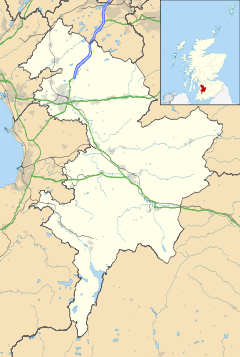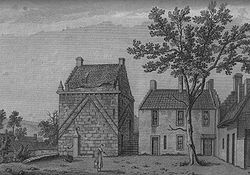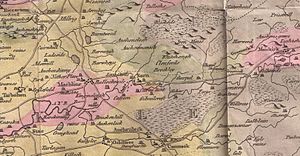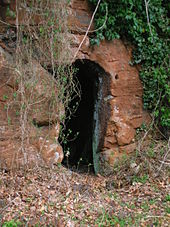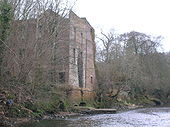- Mauchline
-
Coordinates: 55°30′58″N 4°22′44″W / 55.516°N 4.379°W
Mauchline Scottish Gaelic: Machlainn
 Mauchline shown within East Ayrshire
Mauchline shown within East AyrshireOS grid reference NS498272 - Edinburgh 70 mi (110 km) SW - London 380 mi (610 km) SSE Council area East Ayrshire Lieutenancy area Ayrshire and Arran Country Scotland Sovereign state United Kingdom Post town MAUCHLINE Postcode district KA5 Dialling code 01290 Police Strathclyde Fire Strathclyde Ambulance Scottish EU Parliament Scotland UK Parliament Kilmarnock and Loudoun Scottish Parliament Carrick, Cumnock and Doon Valley Website www.mauchlinevillage.co.uk List of places: UK • Scotland • Mauchline (pronounced IPA: /ˈmɒxlɪn/; Scottish Gaelic: Machlainn) is a town in East Ayrshire, Scotland. In the 2001 census it had a recorded population of 4105. It lies by the Glasgow and South Western Railway line, 8 miles (13 km) east-southeast of Kilmarnock and 11 miles (18 km) northeast of Ayr. It is situated on a gentle slope about 1 mile (2 km) from the River Ayr, which flows through the south of the parish of Mauchline. In former days Loch Brown was about 1 mile west of the town, but was drained when the railway line from Kilmarnock was built.
Contents
History
The first mention of Mauchline is in reference to a battle fought on Mauchline Moor in 681 between the Picts and the Scots, with a further battle being fought in 702. In 1165, Walter fitz Alan, High Steward of Scotland, granted a charter giving land to the Cistercian Monks of Melrose. In those days the parish extended to the border with Lanarkshire at Glenbuck. The monks built an abbey, the ruins of which still exist and are known as Hunters Tower or, more recently, as Mauchline Castle. Mauchline was created a burgh of barony by James IV in 1510 and was granted a further charter in 1610; both these charters however have been lost, believed to have perished in a fire at Register House, Edinburgh, in the 17th century. A ley tunnel is said to run from the castle of Mauchline to that of Kingencleugh.[1]
Mauchline featured in the Scottish Reformation. After the reformation the lands of Mauchline passed into the hands of the Earl of Loudoun, and no further historical events are recorded in the parish.
The Holy Fair has been revived as an annual event in Mauchline.
Scottish Reformation
In 1544 George Wishart, an influential Protestant preacher, visited Mauchline to find the doors of St Michael's church barred against him. His reaction to this was to retreat to Mauchline Moor and to preach for over three hours to a large congregation, under the watchful eye of the Sheriff of Ayr and an armed force. John Knox also preached in Mauchline in 1599 after his return from exile in France and Switzerland. When the Scottish Parliament adopted the Scots Confession of 1560, the reformation was immediately accepted in Mauchline.
Later, Mauchline became something of a stronghold for the Covenanter movement. Mauchline Parish's minister at the time, Reverend George Young, signed the Covenant in Greyfriars Church in Edinburgh in 1633 and subscribed to the Solemn League and Covenant in 1643, and several battles and skirmishes took place in the area during the Wars of the Three Kingdoms. In 1684 the Covenanter James Smith was wounded during a skirmish at Burn of Ann in Kyle. He was taken to Mauchline where he died in prison. In 1685 five men from the town were dragged out of their homes and executed at the loan. A monument was placed over their grave (this was removed in 1861 and replaced by a plinth, with the original monument being built into the wall of the school shed where it stands to this day). The Battle of Mauchline Muir took place in 1648 between Covenanters and Royalist troops. A Covenanters' flag from this battle still hangs in the church. The flag was also carried at the battles of Drumlog and Bothwell Brig.
Trade
The village has at some point been a centre for quarrying sandstone, clock making, box-work, and the production of curling stones.
The sandstone quarry dates back to the 18th century. The peak of production and demand was at the turn of the 19th century when over 200 men were employed at the quarry. A railway siding was installed and as many as 60 wagons a day were transported from Mauchline. Many old building throughout the West of Scotland are built with Mauchline sandstone, and stone was being sent as far away as America. After 1918 the use of sandstone declined (houses were built with bricks instead) and this coupled with increased costs meant that eventually, in the 1950s, the last quarry closed.
In the 18th century, Mauchline was renowned for clock making – John "Clockie" Brown is buried in the Kirkyard. The industry declined in the 19th century.
The production of box-work or Mauchline ware took place from the 1820s until 1933 by the firm of W & A Smith. These boxes were extremely collectable. They ranged from the basic transfer as on small vases, each piece having the view of the place of purchase. These went from Mauchline to the Isle of Wight. Tartan ware was also extremely popular as a result of the smiths inventing a machine for "weaving" tartan designs on paper. Fernware was introduced in the 1870s. This involved applying actual ferns to the wood which was then stippled in dark brown, the ferns removed and the wood varnished. The wood used was Sycamore. These products were sent all over the world. A fire in 1933 stopped production, which was never restarted.
The making of curling stones began in the 19th century and for many years experienced full production, however for various reasons, the industry began to decline. Forty people were employed in the 1960s compared to a dozen now. However, the curling stone factory (now owned by Andrew Kay & Co) is now the only one of its kind in the world, leading to an upsurge in trade.
Robert Burns
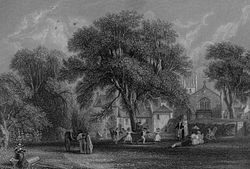 A view of Mauchline and the house of Gavin Hamilton in 1840[2]
A view of Mauchline and the house of Gavin Hamilton in 1840[2]
Robert Burns, Scotland's National Poet came to live on the outskirts of the village at Mossgiel farm in 1784. Many of his poems are believed to have been written whilst he was there, notably The Holy Fair, To a Mouse, and Holy Willie's Prayer. Many of his poems were directed towards the perceived hypocrisy of the Church. The Church was particularly fanatical in Mauchline, which conflicted with the liberal attitude of Burns and his friends. The minister in Burns's time was the Rev William Auld of Old Helenton near Symington, South Ayrshire. Nonetheless Burns made many friends (his wife Jean Armour was born in Mauchline) and a lot of enemies whilst in Mauchline, many of whom are buried in the kirkyard: "Holy Wullie" Willie Fisher, the Reverend William "Daddy" Auld, John Richmond, "Clockie" Brown and notably Gavin Hamilton his best friend. The plaque which marks Hamilton's grave was only placed there in 1919 by the Partick Burns Club. Gavin Hamilton had stated that he wanted no headstone, probably due to his run-ins with the Church in Mauchline.
Kirkyard
As well as containing the remains of many of Burns' contemporaries, including the man generally assumed to be the model for 'Holy Willie', Mauchline Kirkyard is the resting place of the last leader of the Chartist movement George Julian Harney.
Transport
Mauchline railway station was closed in 1965, however the line Glasgow South Western Line is still open. The nearest open station is Auchinleck.
References
External links
Categories:- Towns in East Ayrshire
Wikimedia Foundation. 2010.

